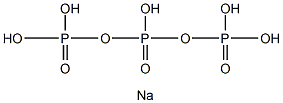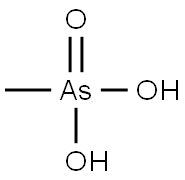Sodium cacodylate 97+
- CAS NO.:124-65-2
- Empirical Formula: C2H6AsNaO2
- Molecular Weight: 159.98
- MDL number: MFCD00002096
- EINECS: 204-708-2
- SAFETY DATA SHEET (SDS)
- Update Date: 2024-12-18 14:15:32

What is Sodium cacodylate 97+?
Chemical properties
White crystalline powder
Chemical properties
Sodium cacodylate is a white crystalline solid which occurs as the trihydrate. It liquefies in the water of hydration @ 60°C and becomes anhydrous @ 120°C.
The Uses of Sodium cacodylate 97+
Herbicide.
Definition
ChEBI: The organic sodium salt of dimethylarsinate.
General Description
A white crystalline or granular solid with a slight odor. Toxic by ingestion, inhalation, and skin absorption. Used as a herbicide.
Air & Water Reactions
Soluble in water.
Reactivity Profile
Sodium cacodylate 97+ gives basic solutions in water. Corrodes common metals, but reaction is not hazardous. [USCG, 1999]. Liquefies in its own water of crystallization when heated to 60°C; becomes anhydrous at 120°C [Merck]. Burns with a bluish flame, emitting a garlic-like odor [Merck].
Hazard
Toxic by inhalation and ingestion.
Health Hazard
Moderately toxic; probable oral lethal dose in humans is 0.5-5 g/kg or between 1 ounce and 1 pint (or 1 lb.) for a 70 kg (150 lb.) person. It may cause disturbances of the blood, kidneys, and nervous system.
Fire Hazard
Poisoning potential is high when heated to decomposition, or on contact with acids or acid fumes, because Sodium cacodylate 97+ emits highly toxic fumes of arsenic. Avoid water solution in contact with active metals (iron, aluminum, zinc).
Agricultural Uses
Herbicide, Rodenticide, Defoliant, Veterinary medicine: This material has been used as a non-selective herbicide and defoliant for general weed control. Severely restricted for use in EU countries. Not registered for use in the U.S. There are 47 global suppliers
Trade name
ACME® Sodium cacodylate; ALKARSODYL®; ANSAR 160®; ARSECODILE®; ARSYCODILE®; BOLLS-EYE®; CHEMAID®; DREXEL EZY-PICKIN COTTON DEFOLIANT®; DREXEL KACK HERBICIDE®; DUTCH-TREAT®; HERB-ALL®; PHYTAR 560® (with Cacodylic acid); RAD-E-CATE®; SILVISAR®
Potential Exposure
This material has been used as a nonselective herbicide and for general weed control.
Shipping
UN1688 Sodium cacodylate Hazard Class: 6.1; Labels: 6.1-Poisonous materials. UN3465 Organoarsenic compound, solid, n.o.s., Hazard Class: 6.1; Labels: 6.1Poisonous materials, Technical Name Required
Purification Methods
Recrystallise it from aqueous EtOH. [Beilstein 4 H I 612.]
Incompatibilities
Incompatible with oxidizers, strong bases; acids, active metals (iron, aluminum, zinc). Contact with acids react to form highly toxic dimethylarsine gas. Attacks some metals.
Waste Disposal
For cacodylic acid, precipitate as calcium arsenate and calcium arsenite by treatment with excess lime water. Recycle if possible. If not, put in secure storage for possible disposal in leach-proof dumps. In accordance with 40CFR165, follow recommendations for the disposal of pesticides and pesticide containers. Must be disposed properly by following package label directions or by contacting your local or federal environmental control agency, or by contacting your regional EPA office.
Properties of Sodium cacodylate 97+
| Melting point: | 200°C |
| Boiling point: | 200°C |
| storage temp. | Store at RT. |
| solubility | H2O: 0.5 M at 20 °C, clear, colorless |
| form | solid |
| PH | pH (50g/l, 25℃) : 7.5~9.5 |
| Stability: | Stable. |
| CAS DataBase Reference | 124-65-2(CAS DataBase Reference) |
| EPA Substance Registry System | Sodium cacodylate (124-65-2) |
Safety information for Sodium cacodylate 97+
| Signal word | Danger |
| Pictogram(s) |
 Skull and Crossbones Acute Toxicity GHS06  Environment GHS09 |
| GHS Hazard Statements |
H410:Hazardous to the aquatic environment, long-term hazard |
| Precautionary Statement Codes |
P261:Avoid breathing dust/fume/gas/mist/vapours/spray. P273:Avoid release to the environment. P311:Call a POISON CENTER or doctor/physician. P301+P310:IF SWALLOWED: Immediately call a POISON CENTER or doctor/physician. P501:Dispose of contents/container to..… |
Computed Descriptors for Sodium cacodylate 97+
New Products
(S)-3-Aminobutanenitrile hydrochloride 4-Methylphenylacetic acid N-Boc-D-alaninol N-BOC-D/L-ALANINOL Tert-butyl bis(2-chloroethyl)carbamate 3-Morpholino-1-(4-nitrophenyl)-5,6-dihydropyridin- 2(1H)-one Furan-2,5-Dicarboxylic Acid Tropic acid 1-Bromo-3,5-Di-Tert-Butylbenzene S-2-CHLORO PROPIONIC ACID ETHYL ISOCYANOACETATE 2-Bromo-1,3-Bis(Dimethylamino)Trimethinium Hexafluorophosphate 4-IODO BENZOIC ACID 3-NITRO-2-METHYL ANILINE 1-(2,4-DICHLOROPHENYL) ETHANAMINE (2-Hydroxyphenyl)acetonitrile 4-Bromopyrazole 2-(Cyanocyclohexyl)acetic acid 4-methoxy-3,5-dinitropyridine 1-(4-(aminomethyl)benzyl)urea hydrochloride 2-aminopropyl benzoate hydrochloride diethyl 2-(2-((tertbutoxycarbonyl)amino) ethyl)malonate tert-butyl 4- (ureidomethyl)benzylcarbamate Ethyl-2-chloro((4-methoxyphenyl)hydrazono)acetateRelated products of tetrahydrofuran








You may like
-
 Sodium cacodylate CAS 124-65-2View Details
Sodium cacodylate CAS 124-65-2View Details
124-65-2 -
 Sodium Cacodylate Trihydrate CAS 124-65-2View Details
Sodium Cacodylate Trihydrate CAS 124-65-2View Details
124-65-2 -
 1975-50-4 98%View Details
1975-50-4 98%View Details
1975-50-4 -
 2-HYDROXY BENZYL ALCOHOL 98%View Details
2-HYDROXY BENZYL ALCOHOL 98%View Details
90-01-7 -
 2-Chloro-1,3-Bis(Dimethylamino)Trimethinium Hexafluorophosphate 221615-75-4 98%View Details
2-Chloro-1,3-Bis(Dimethylamino)Trimethinium Hexafluorophosphate 221615-75-4 98%View Details
221615-75-4 -
 61397-56-6 CIS BROMO BENZOATE 98%View Details
61397-56-6 CIS BROMO BENZOATE 98%View Details
61397-56-6 -
 14714-50-2 (2-Hydroxyphenyl)acetonitrile 98+View Details
14714-50-2 (2-Hydroxyphenyl)acetonitrile 98+View Details
14714-50-2 -
 118753-70-1 98+View Details
118753-70-1 98+View Details
118753-70-1